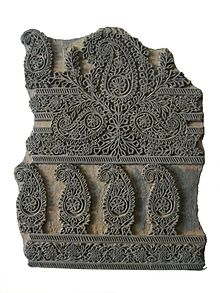Woodblock printing on textiles
For example, there is direct evidence that peoples in South Asia, including some from Punjab and Mumbai, extensively used printing for textile decoration from early on.
[7] As in the case of weaving and embroideries, specimens of printed stuffs have of recent years been obtained from disused cemeteries in Upper Egypt (Akhmim and elsewhere) and tell us of Egypto-Roman use of such things.
Apart from these there are wall paintings, e.g., those of Beni Hasan (c. 2200–1800 BC), which depict Egyptian people wearing costumes irregularly patterned with spots, stripes and zigzags, which may have been more easily stamped than embroidered or woven.
A more complicated and orderly pattern well suited to stamping occurs in a painting about 1320 BC, of Hathor and King Meneptha I. Herodotus, referring to the garments of inhabitants of the Caucasus, showing representations of various animals.
Museum specimens establish the fact that more important pattern printing on textiles had become a developed industry in parts of Europe towards the end of the 12th and the beginning of the 13th century.
According to Forrer (Die Kunst des Zeugdrucks, 1898) medieval Rhenish monasteries were the cradles of the artistic craft of ornamental stamp or block cutting, although it is now recognised that some of the examples he relied on are modern forgeries.
Of these, and of a considerable number of later variously dyed stout linens with patterns printed in dark tones or in black, specimens have been collected from reliquaries, tombs and old churches.
The blockcutter commences by carving out the wood around the heavier masses first, leaving the finer and more delicate work until the last so as to avoid any risk of injuring it during the cutting of the coarser parts.
In this case the metal strips are driven to a predetermined depth into the face of a piece of lime-wood cut across the grain, and, when the whole design is completed in this way, the block is placed, metal face downwards in a tray of molten type-metal or solder, which transmits sufficient heat to the inserted portions of the strips of copper to enable them to carbonize the wood immediately in contact with them and, at the same time, firmly attaches itself to the outstanding portions.
When cold a slight tap with a hammer on the back of the limewood block easily detaches the cake of the type-metal or alloy and along with it, of course, the strips of copper to which it is firmly soldered, leaving a matrix, or mold, in wood of the original design.
The casting is made in an alloy of low melting-point, anti, after cooling, is filed or ground until all its projections are of the same height and perfectly smooth, after which it is screwed onto a wooden support and is ready for printing.
The table consists of a stout framework of wood or iron supporting a thick slab of stone varying in size according to the width of cloth to be printed.
Over the stone table top a thick piece of woolen printers blanket is tightly stretched to supply the elasticity necessary to give the block every chance of making a good impression on the cloth.
The printer commences by drawing a length of cloth, from the roll, over the table, and marks it with a piece of coloured chalk and a ruler to indicate where the first impression of the block is to be applied.
They then applies the block in two different directions to the colour on the sieve and finally presses it firmly and steadily on the cloth, ensuring a good impression by striking it smartly on the back with a wooden mallet.






